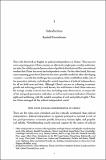|
Reseña:
|
Reseña:There is therefore a pressing need to get beyond outdated stereotypes and broadgeneralizations, to examine a wider range of cases than just high-profile conflictsinvolving political dissidents so prominently featured in the reports of human rightsgroups and the Western media, and to overcome the knee-jerk reaction to blameall judicial shortcomings on the party and lack of U.S.-style separation of powers. Inshort, there is a need formore nuanced studies, new analytic frameworks, and thickerdescriptions of the actual issues judges face in their daily lives, the reasons for existingpolicies, and the responses of the judiciary to such policies. The development of thelegal system in China must also be situated within a broader comparative frameworkof other developing countries, many of which are experiencing similar issues.Even assuming the conventional wisdom is correct and judicial independence isnecessary or useful for many of the goals mentioned previously, there is still the allimportantquestion of how to achieve it. Thus a fourth goal is to scrutinize the dominantapproach of the rule of law industry to prescribing “international best practices.”It is now clear in light of the historical development of legal systems in Euro-America,Asia, and some countries in Eastern Europe, Latin America, and the Middle Eastthat there is no single path toward the rule of law and that rule of law principles areconsistent with a wide variety of institutional arrangements, although implicationsfor policymakers are far from clear.Moreover, the less than spectacular results of ruleof law promotion efforts call into question the role and influence of foreign actors,as well as the assumption that the best way for developing states to achieve rule oflaw is to mimic or transplant Euro-American institutions, values, and practices.China is an interesting test case in that it has pursued its own approach to reforms.China did not adopt the big bang approach to economic reforms or follow the neoliberalaspects of the Washington Consensus, including rapid privatization, deregulation,and opening of the domestic economy to international competition. Likeother successful East Asian states, it has postponed democratization until it attains ahigher level of economic and institutional development. Also, like other successfulEast Asian states, it has adopted a two-track approach to legal development thatThere is therefore a pressing need to get beyond outdated stereotypes and broad generalizations, to examine a wider range of cases than just high-profile conflicts involving political dissidents so prominently featured in the reports of human rights groups and the Western media, and to overcome the knee-jerk reaction to blame all judicial shortcomings on the party and lack of U.S.-style separation of powers. In short, there is a need formore nuanced studies, new analytic frameworks, and thicker descriptions of the actual issues judges face in their daily lives, the reasons for existing policies, and the responses of the judiciary to such policies. The development of the legal system in China must also be situated within a broader comparative framework of other developing countries, many of which are experiencing similar issues.Even assuming the conventional wisdom is correct and judicial independence is necessary or useful for many of the goals mentioned previously, there is still the allimportant question of how to achieve it. Thus a fourth goal is to scrutinize the dominant approach of the rule of law industry to prescribing “international best practices.” It is now clear in light of the historical development of legal systems in Euro-America, Asia, and some countries in Eastern Europe, Latin America, and the Middle East that there is no single path toward the rule of law and that rule of law principles are consistent with a wide variety of institutional arrangements, although implications for policymakers are far from clear. Moreover, the less than spectacular results of rule of law promotion efforts call into question the role and influence of foreign actors, as well as the assumption that the best way for developing states to achieve rule of law is to mimic or transplant Euro-American institutions, values, and practices.China is an interesting test case in that it has pursued its own approach to reforms. China did not adopt the big bang approach to economic reforms or follow the neoliberal aspects of the Washington Consensus, including rapid privatization, deregulation, and opening of the domestic economy to international competition. Like other successful East Asian states, it has postponed democratization until it attains a higher level of economic and institutional development. Also, like other successful East Asian states, it has adopted a two-track approach to legal development thatemphasizes commercial law while imposing limits on the exercise of civil and politicalrights. But what are the costs of this gradualist approach? Will China be able to maintain and deepen the reform agenda, or will the reform process stall, leaving China another example of a dysfunctional middle-income state that once showed great promise? |



